2012 Annual Product Review
 Adjusting to the challenging global economy of 2012, many connector manufacturers focused more on filling out existing product offerings to better match immediate system packaging needs and emerging trends rather than introducing groundbreaking new products.
Adjusting to the challenging global economy of 2012, many connector manufacturers focused more on filling out existing product offerings to better match immediate system packaging needs and emerging trends rather than introducing groundbreaking new products.
Offering connector product lines that feature good, better, and best options provides the ability to deliver the needed performance at the lowest cost while staying within a preferred product family. The different performance grades may offer optimized grounding, increased signal isolation, higher current rating, greater contact density, or better noise margin. To a large degree, incremental advances in connector technology made over the past few years have kept pace with the needs of the industry. Ongoing trends that include durability, higher data rates, tighter packaging density, and increased power consumption continue to shape new product development and are reflected in new and expanded connector families introduced over the past year.
It now appears that several emerging trends will add to the influences that will impact future interconnect systems.
Incredible advances in silicon fabrication continue to push geometry ever smaller, which allows greater integration of features on the die. Processor speeds will continue to grow, but the challenge is how to get the data out of the chip fast enough. Interest is growing in optical output directly from the processor. Emphasis on individual CPU clock speed is being replaced by increasing the use of multicore processors that can simultaneously handle multiple tasks while consuming less power.
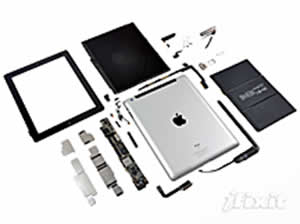 To a large degree, system packaging of new products is being impacted by functional integration at the chip level. One is struck by the relatively few components inside the Apple iPad. Most devices are soldered directly to several small PCBs, which are interconnected with short, flat flex cables.
To a large degree, system packaging of new products is being impacted by functional integration at the chip level. One is struck by the relatively few components inside the Apple iPad. Most devices are soldered directly to several small PCBs, which are interconnected with short, flat flex cables.
Packing more functionality in smaller spaces has enabled the incredible boom in mobile devices, a trend that is making the desktop obsolete and threatens the laptop. The smartphone and tablet are quickly becoming the preferred choice for communications, information, and entertainment. Advances in battery chemistry allow smaller and lighter batteries to run longer and charge more quickly.
Traditional broadcast and cable television is feeling the pressure as more streaming content is becoming available. Ever more powerful silicon will generate demand on the infrastructure that is being driven by user-created video content, thousands of mobile device apps, and an emerging host of IP-addressed home appliances and commercial equipment, making the smart home and wireless industrial control a reality. The “Internet of People” is quickly being replaced by the “Internet of Things.”
Emphasis on connectors used in power circuits is focused on minimizing loss and heat. Many new power connectors are modular, allowing easy customization. Low-profile and vented connectors minimize cooling airflow obstruction. Improved contact designs, base materials, and plating metallurgy reduce contact resistance and insure performance under shock and vibration. These advances are also resulting in smaller contacts with higher current ratings.
Physically smaller devices offer little space for I/O connectors in both portable consumer products as well as servers in large data centers. Microminiature USB and DisplayPort connectors are increasingly being used for transmission of multiple I/O protocols as well as battery charging. The recently introduced eight-pin Lightning dock connector on the Apple iPhone 5 includes ruggedness in a consumer-friendly interface replacing the standard 19-pin connector. The introduction of this new connector also reflects the trend toward greater data transfer via wireless technology and inductive charging. The evolution to wireless, including near-field communication (NFC), will likely continue the trend toward minimizing the number and type of connectors on many electronic devices.
Fiber optic technology has long been predicted as a replacement for many high-speed copper interfaces, but advances in signal conditioning, along with the traditionally higher cost of the electro-optic conversion process, has delayed broad market utilization. We may finally be close to the economic tipping point where optics achieve cost parity while offering extreme bandwidth headroom, size/weight reduction, security, and reach. We’ll wait to see what happens when Intel releases the LightPeak optical twin to its Thunderbolt copper connector. Advances in silicon photonics eliminate multiple components and offer a clear migration path to higher-speed I/O, as well as reduce size and weight. Speed and reach are critical aspects of next-generation equipment. Twenty-five Gb/s may be the practical limit of copper backplane interconnects, especially as the industry migrates toward 100+ Gb/s external Ethernet links.
The “electronification” of traditionally mechanical devices, along with the migration of electronic equipment exposed to harsh environments, has stimulated the introduction of a host of ruggedized standard interfaces such as RJ45 and USB, as well as entirely new connectors that feature tough shells and extensive sealing systems. Applications that range from cellular phone towers to satellites that demand reliable separable connectors and can withstand temperature extremes, vibration, dust, moisture, and rough handling are driving this market growth.
It is unclear how the expansion of cloud computing will impact electronic devices in the future, but it appears that this technology has the potential to move computing power from individual devices to more centralized data centers and storage facilities. Intelligent systems that are interconnected and managed remotely are another category of devices that will shape connector demands in the future. Both require increased bandwidth, which will likely stimulate upgrades of the infrastructure.
Many of the new interconnect products introduced this year support these continuing and emerging trends.
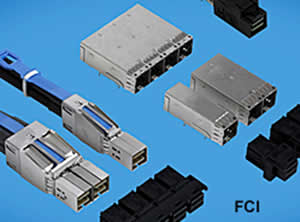 Demand for faster I/O that can fit in reduced panel spaces is being addressed by the Mini SAS HD connector from FCI and Molex. Their external Mini-SAS HD interface PCB connector and cables support proposed SAS 3.0 speeds at up to 12 Gb/s with increased port density.
Demand for faster I/O that can fit in reduced panel spaces is being addressed by the Mini SAS HD connector from FCI and Molex. Their external Mini-SAS HD interface PCB connector and cables support proposed SAS 3.0 speeds at up to 12 Gb/s with increased port density.
Pluggable high-speed I/O interfaces such as SFP+, QSFP+ and CXP saw dramatic increases in copper and fiber product introductions from Amphenol, Cinch, FCI, Molex, Samtec, Siemon, and TE Connectivity. These high-speed interfaces address both increased bandwidth as well as I/O panel density.
Power connectors introduced over the past year continue to push the envelope of capacity while increasing contact density. New configurations that feature vertical and right-angle interconnects provide increased designer options.
The EXTreme Ten60 Power Connector from Molex is the latest addition to its portfolio of high-power/ high performance pluggable connectors. This modular low-profile connector is rated at up to 260 amps per linear inch. At the other end of the scale is the MiniBridge 1.27mm cable connector from ERNI that features contacts rated to 4 amps each.
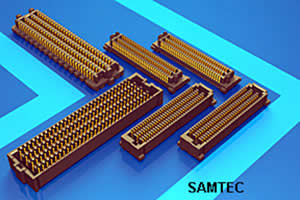 System packaging density continues to drive development of connectors with reduced centerlines. Samtec introduced its Micro Pitch High Density extension of the popular SEARAY stacking connector family with contact centerlines reduced from 1.27mm to 0.8mm, effectively reducing PCB space by 50%.
System packaging density continues to drive development of connectors with reduced centerlines. Samtec introduced its Micro Pitch High Density extension of the popular SEARAY stacking connector family with contact centerlines reduced from 1.27mm to 0.8mm, effectively reducing PCB space by 50%.
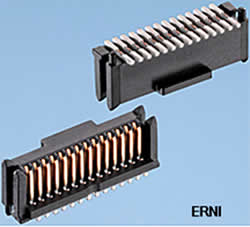 The MicroStac mezzanine connector from ERNI features unique hermaphroditic contacts on 0.8mm centerlines and is designed for fully automatic SMT assembly.
The MicroStac mezzanine connector from ERNI features unique hermaphroditic contacts on 0.8mm centerlines and is designed for fully automatic SMT assembly.
 The new Molex NeoScale mezzanine connector delivers signal integrity at up to 28 Gb/s data transfer rates. This connector utilizes a unique triad wafer design that assures performance over a range of board stack heights. Modular wafers can be customized to match the requirements of individual applications.
The new Molex NeoScale mezzanine connector delivers signal integrity at up to 28 Gb/s data transfer rates. This connector utilizes a unique triad wafer design that assures performance over a range of board stack heights. Modular wafers can be customized to match the requirements of individual applications.
The new InfinX high-speed mezzanine connector jointly offered by FCI and Amphenol is another example of a high- density mezzanine connector that is rated to 25+ Gb/s.
High-speed backplane connectors such as the STRADA Whisper family from TE Connectivity continue to evolve with bandwidth rated to 25 Gb/s. These connectors are offered in standard, orthogonal midplane, and new cabled versions for maximum design flexibility. STRADA Whisper is offered in 100- or 85-ohm differential impedance.
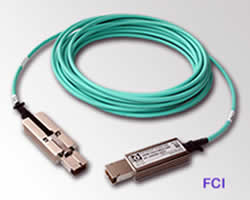 The active optical cable assembly segment is also growing dramatically. Active optical cables terminated in several standard interfaces are being supported by a growing array of suppliers, including 3M, Amphenol, EMCORE, FCI, Fiberon Technologies, Finisar, Mellanox, Samtec, and TE Connectivity.
The active optical cable assembly segment is also growing dramatically. Active optical cables terminated in several standard interfaces are being supported by a growing array of suppliers, including 3M, Amphenol, EMCORE, FCI, Fiberon Technologies, Finisar, Mellanox, Samtec, and TE Connectivity.
Demand for electronic connectors that are capable of surviving in harsh environments has resulted in a number of new options that are sealed against contaminates, including dust and moisture, while sturdy enough to survive exposure to temperature extremes and mechanical abuse. Applications range from geophysical exploration equipment to aerospace.
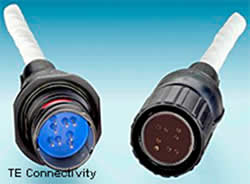 The CeeLok FAS-T connector from TE Connectivity combines ruggedness, small form factor, and the ability to support 10 Gb Ethernet performance in a field-terminable I/O connector.
The CeeLok FAS-T connector from TE Connectivity combines ruggedness, small form factor, and the ability to support 10 Gb Ethernet performance in a field-terminable I/O connector.
Amphenol recently released their ARC Series of fully submersible TNC and type N RF connectors. They are designed for outdoor applications in industrial, military, transportation, and signage markets.
 Advances in solid-state lighting are opening new opportunities for connectors. Leading suppliers, including Amphenol, AVX, FCI, Hirose, JAE, JST, Molex, Samtec, and TE Connectivity have introduced wire-to-board and board-to-board connector systems specifically designed for applications in LED lighting. Molex and TE Connectivity have developed a series of LED sockets designed around specific LED matrix modules.
Advances in solid-state lighting are opening new opportunities for connectors. Leading suppliers, including Amphenol, AVX, FCI, Hirose, JAE, JST, Molex, Samtec, and TE Connectivity have introduced wire-to-board and board-to-board connector systems specifically designed for applications in LED lighting. Molex and TE Connectivity have developed a series of LED sockets designed around specific LED matrix modules.
 Combining the advantages of high-speed cable in a flat, foldable configuration, 3M has been actively expanding applications for its Twin Axial shielded cable. With bandwidth to 25 Gb/s, internal SATA and mini-SAS as well as external Mini-SAS, SFP+, and QSFP+ assemblies are available. 3M also announced a flat HDMI assembly using this technology.
Combining the advantages of high-speed cable in a flat, foldable configuration, 3M has been actively expanding applications for its Twin Axial shielded cable. With bandwidth to 25 Gb/s, internal SATA and mini-SAS as well as external Mini-SAS, SFP+, and QSFP+ assemblies are available. 3M also announced a flat HDMI assembly using this technology.
New connector introductions in 2012 continued to support the electronics industry with high-performance and cost-effective solutions that address the design challenges faced by OEM customers.
- Optics Outpace Copper at OFC 2024 - April 16, 2024
- Digital Lighting Enhances your Theatrical Experience - March 5, 2024
- DesignCon 2024 in Review - February 13, 2024



